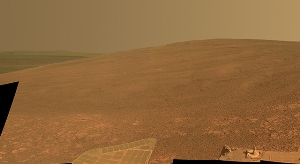Nov 14 2013
Features on Mars important to the missions of NASA's two active Mars rovers are now called "Murray Ridge" and "Murray Buttes," in honor of influential planetary scientist Bruce Murray (1931-2013).
 This scene shows the "Murray Ridge" portion of the western rim of Endeavour Crater on Mars. The ridge is the NASA's Mars Exploration Rover Opportunity's work area for the rover's sixth Martian winter. Image Credit: NASA/JPL-Caltech/Cornell/ASU
This scene shows the "Murray Ridge" portion of the western rim of Endeavour Crater on Mars. The ridge is the NASA's Mars Exploration Rover Opportunity's work area for the rover's sixth Martian winter. Image Credit: NASA/JPL-Caltech/Cornell/ASU
The rover Opportunity, which has been roaming Mars for nearly a decade, is currently climbing Murray Ridge, part of an uplifted crater rim. NASA's newer rover, Curiosity, is headed toward Murray Buttes as the entryway to that mission's main destination.
"Bruce Murray contributed both scientific insight and leadership that laid the groundwork for interplanetary missions such as robotic missions to Mars, including the Mars rovers, part of America's inspirational accomplishments. It is fitting that the rover teams have chosen his name for significant landmarks on their expeditions," said NASA Mars Exploration Program Manager Fuk Li, of NASA's Jet Propulsion Laboratory, Pasadena, Calif.
Murray, a California Institute of Technology planetary geologist, worked on science teams of NASA's earliest missions to Mars in the 1960s and '70s. He was the director of JPL from 1976 to 1982, then returned to teaching and research at Caltech. He co-founded the Planetary Society in 1980 and vigorously promoted public support for planetary exploration missions. He died on Aug. 29, 2013.
NASA's Mars Exploration Rover Opportunity, which has been working on Mars since 2004, has been investigating sites on the western rim of a 14-mile-wide (22-kilometer-wide) crater, Endeavour, for the past two years. The feature, informally named Murray Ridge, is an uplifted portion of the rim, a spine rising southward from "Solander Point" to an elevation about 130 feet (40 meters) above the surrounding plain.
"Murray Ridge is the highest hill we've ever tried to climb with Opportunity," said the mission's principal investigator, Steve Squyres of Cornell University, Ithaca, N.Y. The ridge has outcrops with clay minerals detected from orbit. It also provides a favorable slope for Martian winter sunshine to hit the rover's solar panels, an advantage for keeping Opportunity mobile through the winter.
"Bruce Murray is best known for having been the director of JPL, and JPL is where our rovers were built," Squyres said. "He led JPL during a time when the planetary exploration budget was under pressure and the future for planetary missions was not clear. His leadership brought us through that period with a strong exploration program. He was also a towering figure in Mars research. His papers are still cited abundantly today."
The Curiosity rover is driving from a flatter area where it worked for several months after landing in 2011 to the slopes of a mountain 3 miles (5 kilometers) high, Mount Sharp. Murray Buttes, at the base of the mountain, are a cluster of small, steep-sided knobs, up to about the size of a football field and the height of a goal post. They sit in a gap in a band of dark sand dunes that lie at the foot of the mountain. Deep sand could present a hazard for driving, so this break in the dunes is the access path to the mountain.
"We'll be going right by these buttes when we shoot the gap in the dunes," said Curiosity science-team member Ken Herkenhoff, of the U.S. Geological Survey's Astrogeology Center, Flagstaff, Ariz. "It will be a visually intriguing area for both the science team and the public. I think it will look like a miniature version of Monument Valley in Utah."
Blowing sand from the dunes may scour dust off the buttes, exposing layers of rock for observation by the rover.
Herkenhoff, who was a graduate student of Murray's in the 1980s, said, "Bruce Murray was a sedimentologist, so the sedimentary rocks we expect to see at Murray Buttes would have been especially interesting for him. He would have loved this."
Curiosity's science team plans for Murray Buttes to serve as a corridor from which to launch the rover's climb onto Mount Sharp.
JPL, a division of Caltech, manages the Opportunity and Curiosity missions for NASA's Science Mission Directorate, Washington.
For more information about Opportunity, visit http://www.jpl.nasa.gov/msl , http://www.nasa.gov/rovers and http://marsrovers.jpl.nasa.gov . For more information about Curiosity, visit http://www.nasa.gov/msl and http://mars.jpl.nasa.gov/msl.